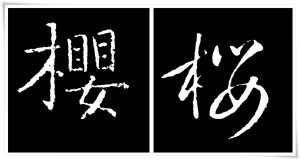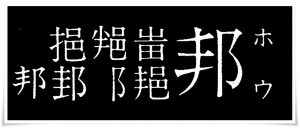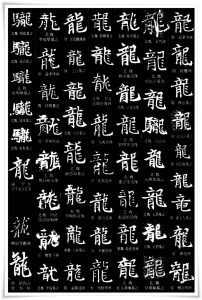One of the keys to understanding the Chinese writing system, and therefore calligraphy, is comprehending the various nuances as well as the specific terminology native to the art of Far Eastern calligraphy. To assist the reader and in parallel with articles, some time ago we launched www.shodopedia.com, a website which currently has over 300 calligraphy terms and calligraphy related historical facts or topics elaborated upon. We plan to add to this database regularly. Thus, at this time I would like to invite you to post comments directly on our blog after you have read this article or any other article released on the Beyond Calligraphy sites, tell us whenever you do not fully understand what we have written or tell us what you may wish to read about in greater detail. The aim of Beyond Calligraphy is to promote calligraphy knowledge and assist artists who are studying or influenced by either calligraphy or ink painting, and we intend to do so in as many languages as humanly possible.

Today, I would like to say a few words about what we call in Japanese itaiji (異体字, いたいじ, i.e. “Chinese character variants”). The history of the Chinese writing system is one of the longest in the world, if not the longest. Shapes and forms, styles and scripts evolved throughout thousands of years, with the result that the majority of characters have multiple forms.
A good calligraphy dictionary contains ink rubbings of five major scripts (i.e. seal script, clerical script, cursive script, standard script, and finally, semi-cursive script). Then, each script has its sub-scripts. For instance, the seal script (篆書, てんしょ, tensho) family includes oracle bone script (甲骨文, こうこつぶん, kōkotsubun), kinbun (金文, きんぶん, i.e. “text on metal”), other great seal script (大篆, だいてん, daiten) forms, and finally small seal script (小篆, しょうてん, shōten) forms.
A given character written in each calligraphy script may have (and usually does) different forms and stroke order, though the stroke order is less rigid in clerical script (隷書, れいしょ, reisho) and nearly non-existent in seal script. This is a complex issue and it requires a separate article, though it was partially discussed in my previous article regarding the importance of stroke order. I am purposely simplifying it here. The historical reasons are many. In ancient China the distance between human dwellings was vast. Thus, extended time was required for communication and information exchange between them. Secondly, there were a multitude of conflicts between kingdoms and tribes with great frequency. This resulted in each sub-territory emphasizing their cultural individuality, and this had a direct impact on the written language. Although the reform of great seal script by Prime Minister Li Si (李斯, pinyin: Lǐ Sī, ca. 280 B.C. – 208 B.C.) in 221 B.C. somewhat standardised the character forms, right to the present day, the multiple forms of characters represent the complex history of China and the Chinese writing system.

Another and quite common reason for multiple character forms is cursive script itself. Why is that? Well, before we all started to use computers, cursive hand was a major way of communicating in written form. No one in China or Japan was writing in standard script (楷書, かいしょ, kaisho) or clerical script, rather always in cursive (草書, そうしょ, sōsho) or semi-cursive (行書, ぎょうしょ, gyōsho) or a blend of both (so called 行草書, ぎょうそうしょ, gyōsōsho). In short, if one could not read cursive script, he or she would not have been able to read. The prolonged use of cursive script in every-day use (over two thousand years) affected many alternate character forms. For example, the character for sakura (cherry blossom) is 櫻 (さくら), but written in cursive or semi-cursive, the double 貝 radical is simplified to three dots which are further merged with 女 (see Figure 1). Thus, this character’s form was simplified and became 桜. Nevertheless both of them are still in use.
Some characters may have as many as seven or even more forms. This is very common for characters that have a special meaning, or sometimes their meaning is related to supernatural powers, the occult, or mythology, although it is not imperative. The character for country (邦, ほう, hō) has so many forms that it is difficult to remember them all (Figure 2). See also Figure 3 which shows various forms of the character 龍 (りゅう, ryū, i.e. “dragon”).

As the language evolved, and there was a need for more specificity, for words that would describe objects, ideas, or instances, etc. in a narrower manner, those types of words began to appear. Strokes were added to some characters, i.e., they were made more complex. Added strokes formed components that were either semantic or phonetic, and they further defined a given character. One example is the character 学 (まなぶ, manabu, i.e. “to learn”), the traditional form is 學. The etymology analysis of 學 shows that the stroke order of this character was made more complex purposely (斅), in order to distinguish among its multiple meanings.
Additionally, please, keep in mind that the written characters form usually differs from the one that you see in a computer font (although computer font is not considered to be a Chinese character variant {異体字}). Now, multiply this by 90,000 characters or more, as there are still many that have not been deciphered as yet, and you get some idea of the complexity of understanding.. Even without delving into linguistics, designating the Chinese writing system as an alphabet would be an insult to one of the most intriguing and continuously evolving wonders of the world.
